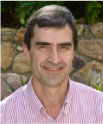Applications of Synchrotron Science to Chemistry
Ian Gentle AA School of Chemistry and Molecular Biosciences, The University of Queensland, Brisbane, Qld 4072, Australia. Email: i.gentle@uq.edu.au

Ian Gentle joined The University of Queensland in 1993, where he is now Professor of Physical Chemistry. His research is in the fields of energy storage, in particular advanced electrode materials for batteries, and organic optoelectronics in the Centre for Organic Photonics and Electronics (COPE). He uses synchrotron X-ray as well as neutron methods extensively in his research. Between October 2008 and December 2010 he was Head of Science at the Australian Synchrotron. |
Australian Journal of Chemistry 65(3) 203-203 https://doi.org/10.1071/CH12098
Published: 21 March 2012
Synchrotron light sources are highly versatile research tools, with applications in a vast range of science from medicine to earth science. In fact, there are few areas of science to which synchrotron radiation cannot make a contribution, which is a credit to the designers of the many synchrotron light sources around the world and to those who have conceived and implemented the many beamlines and end-stations that make such a diverse range of experiments possible. Australia has recently joined the ranks of countries with an advanced third-generation light source since the opening of the Australian Synchrotron (AS) in Clayton, Victoria, in 2007. Synchrotron science in Australia dates back well before the opening of the AS, from the early days when intrepid scientists travelled to early light sources without the support structures that are taken for granted today, through the period of the Australian National Beamline Facility to the Australian Synchrotron Research Program (ASRP). The ASRP was a visionary programme that provided the experience and much of the impetus needed for Australian scientists to push for the establishment of a synchrotron light source in Australia and from that came the AS as we know it today. Although still in its early stages of development and with only 9 of a possible 38 beamlines, the AS has a user base of over 3000 scientists and an output of over 250 papers with AS data in 2011 alone.
Many of the current beamlines are useful to those in the chemical sciences. Some, such as infrared spectroscopy, are methods that are quite familiar to chemists. The synchrotron infrared microspectroscopy beamline offers advantages over its laboratory counterpart such as greatly increased signal-to-noise ratio and the ability to perform mapping rapidly and with high spatial resolution, but is nevertheless quite similar at heart to an instrument that may be found in a lab, albeit with a synchrotron as the source of IR radiation. Others, with the X-ray absorption spectroscopy (XAS) beamline being a good example, rely on the unique properties of synchrotron radiation and offer capabilities that cannot be achieved without a synchrotron. XAS offers unique opportunities for structural studies of metal centres that are of enormous value to chemists, biologists and materials scientists.
This issue of Aust. J. Chem. contains a selection of papers by Australian groups that demonstrate some of the power of synchrotron radiation when applied to chemical problems. While some are more in the style of reviews and others are research articles, all give a useful perspective on how this versatile tool is a powerful weapon in the chemist’s armoury. A short review on applications of synchrotron radiation to medicinal chemistry[1] gives a summary of the way several beamlines (microprobe X-ray fluorescence imaging, XAS and infrared microspectroscopy) can individually and in combination be used to help solve important problems in the chemistry of health, while applications of infrared spectroscopy to biological systems is the focus of another review.[2] Other papers come from a materials chemistry perspective, highlighting the use of synchrotron powder diffraction for the structural elucidation of perovskite oxides,[3] the application of small angle scattering to the study of superhydrophobic surfaces,[4] structure determination of triiron carbonyl sulfide clusters using X-ray absorption spectroscopy[5] and finally a demonstration of the power of in-situ measurements combining electrochemistry and X-ray diffraction to study electrocrystallization.[6]
As more sources come into service and beamlines are constructed and upgraded, synchrotron techniques will continue to grow in importance to chemists. It is encouraging to see the breadth and quality of science being produced by Australian scientists using these techniques, and provided governments continue to recognize the importance and power of synchrotron science, there are exciting times ahead.
References
[1] C. T. Dillon, Aust. J. Chem. 2012, 65, 204.| Crossref | GoogleScholarGoogle Scholar |
[2] D. McNaughton, B. R. Wood, Aust. J. Chem. 2012, 65, 218.
| Crossref | GoogleScholarGoogle Scholar |
[3] B. J. Kennedy, I. Qasim, E. Reynolds, T.-Y. Tan, Q. Zhou, Aust. J. Chem. 2012, 65, 229.
| Crossref | GoogleScholarGoogle Scholar |
[4] J. Cho, L. Palmer, A. Wu, I. Liaw, D. Cookson, R. Lamb, Aust. J. Chem. 2012, 65, 254.
| Crossref | GoogleScholarGoogle Scholar |
[5] J. Yeo, M. H. Cheah, M. I. Bondin, S. P. Best, Aust. J. Chem. 2012, 65, 241.
| Crossref | GoogleScholarGoogle Scholar |
[6] J.-P. Veder, A. Nafady, G. Clarke, R. De Marcoa, A. M. Bond, Aust. J. Chem. 2012, 65, 236.
| Crossref | GoogleScholarGoogle Scholar |


